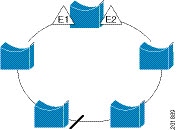Restrictions for Resilient Ethernet Protocol
-
With respect to control frames, REP ALT port will block only tagged (part of Trunk EFP) control frames and not untagged (part of Untagged EFP) control frames.
-
You must configure each segment port; an incorrect configuration can cause forwarding loops in networks.
-
REP can manage only a single failed port within the segment; multiple port failures within the REP segment causes high loss of network connectivity.
-
You should configure REP only in networks with redundancy. Configuring REP in a network without redundancy causes loss of network connectivity.
-
Use LSL timers of 520mseconds to avoid REP flaps.
-
The rate at which the layer 3 packets are punted to Host Q must be lesser than 1000 packets/second to avoid REP flap. The credit limit for Host Q is 1000 packets/second.
-
There is no drop in REP LSL packet in STP Queue.
-
REP is supported only on Trunk EFPs configured on the interfaces.
-
REP enabled port do not support EFP configuration.
-
The recommended minimum REP LSL timer value is 200 ms.
-
The REP ports are removed from the topology list during the following situations:It is designed to avoid the traffic loop based on the above behavior to adopt dynamic REP configuration changes.
-
New port is added after the removal of the old port.
-
Both REP ports are removed.
-
The port is an Edge or Edge no neighbor port.
-
-
A switch can support a maximum of 7 closed REP segments and 14 open REP segments.
-
The recommended upper limit on the number of switches in a REP segment is 32.
-
On a switch, a maximum of two ports can belong to a particular REP segment.
-
REP enabled port do not support EFP configuration.
-
SNMP trap for REP is not supported.






 Feedback
Feedback